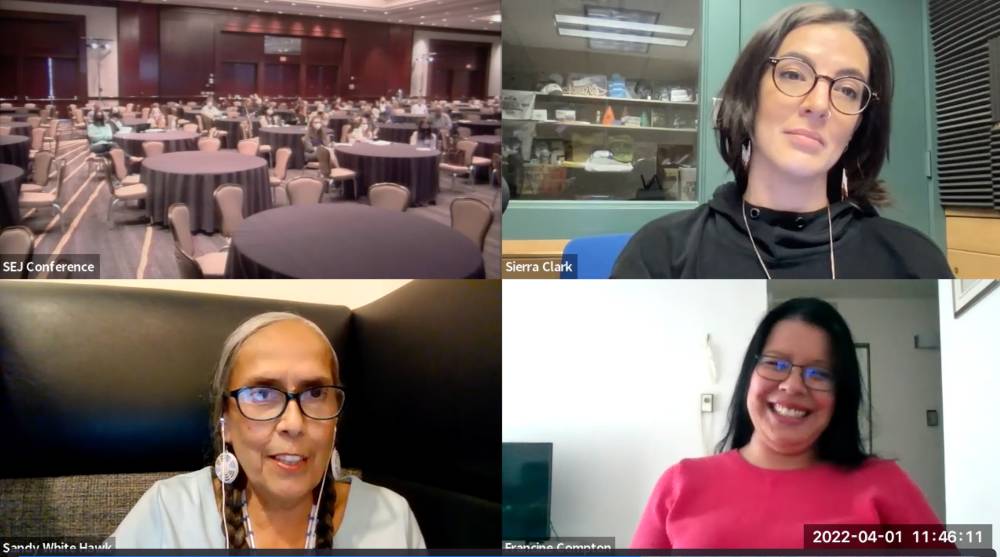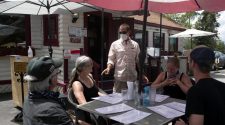
- Details
- By Valerie Vande Panne
-
Today we are hosting a panel discussion at the Society of Environmental Journalists 2022 Conference: Covering Indian Country for Non-Natives.
Our panelists are: Sierra Clark, reporter; Sandy WhiteHawk, source; and Francine Compton, journalist and Native American Journalists Association (NAJA) president.
These are three powerful people from tribes across Indian Country whose words hit with the full force of truth for a full hour and 15 minutes. Attending the panel were, perhaps, the quietest group of reporters I’ve ever seen. They listened. They took notes. They pondered what they heard.
Francine spoke about NAJA’s “bingo card,” encouraging the reporters to use it and if they got “bingo,” or even close to “bingo,” there is probably something seriously wrong with the reporting, among other things, including the NAJA Spotlight Report, analyzing the New York Times’ generally poor coverage of Native Americans.
Never miss Indian Country’s biggest stories and breaking news. Sign up to get our reporting sent straight to your inbox every weekday morning.
Sierra spoke about what it’s like working in a newsroom as the only Indigenous person.
And Sandy spoke about what reporters do wrong when they interview her–and it was a lot.
Because journalism is inherently extractive.
I could wax poetic about the deep insights these powerful women shared–but instead encourage you to watch, or listen, to the panel for yourself, here.
Since our panel was happening in the same room as the luncheon plenary, we ended promptly at 12:15 p.m., as hungry reporters made their way in for lunch.
And it was during the luncheon plenary when I started to feel saucily cynical, as I hear tech bros brag about batteries and carbon capture and I smell the stench of capitalistas vying for media ink and attention.
At a conference of journalists.
As one attendee told me afterward: “This panel made me realize environmental journalists aren’t necessarily environmentalists.”
Truth.
I politely excused myself from the luncheon, which sounded like a sales pitch from five men from Meta on a TEDx stage.
When I got into the hallway, other women were there and more followed me out. As one woman put it: “I can’t believe the main plenary is a manel.”
Manel [man-l] noun. An all-male panel discussion.
After some time chatting with other women in the halls, it’s time for the next panel, on landfills, and then a special U.S. EPA press conference, which was not so much groundbreaking as it was disappointing–more cheerleading than answers or accountability. Some of the regional representatives, who were scheduled to be available to answer press questions directly, never showed up.
As the afternoon wore into evening, I felt relief that our panel was so well-received. I continue to hear kind words about it, which is nice.
We really don’t use enough words saying what is right in journalism, let alone society. The feedback is and was appreciated.
Watch: Covering Indian Country for Non-Natives
Read previous reporter’s notebooks from SEJ:
Reporters Notebook from: Society of Environmental Journalists 2022 Conference, Day Two
Reporters Notebook from the Society of Environmental Journalists 2022 Conference, Day One
More Stories Like This
Passamaquoddy One Step Closer to Regulating their Own Water Supply
U.S. Secretary of Energy Visits Navajo Nation
$46 Million Announced to Combat Impacts of Climate Change in Tribal Communities
Reporter’s Notebook from: Society of Environmental Journalists 2022 Conference, Day Two
Do you appreciate a Native perspective on the news?
For the past decade-plus, we’ve covered the important Indigenous stories that are often overlooked by other media. From the protests at Standing Rock and the toppling of colonizer statues during the racial equity protests, to the ongoing epidemic of Murdered and Missing Indigenous Women (MMIW) and the past-due reckoning related to assimilation, cultural genocide and Indian Boarding Schools, we have been there to provide a Native perspective and elevate Native voices.
Our news is free for everyone to read, but it is not free to produce. That’s why we’re asking you to make a donation this month to help support our efforts. Any contribution — big or small — helps us remain a force for change in Indian Country and continue telling the stories that are so often ignored, erased or overlooked.
Donate to Native News Online today and support independent Indigenous journalism. Thank you.














